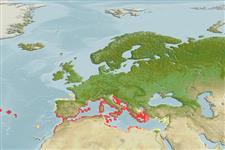Common names from other countries
>
Eupercaria/misc (Various families in series Eupercaria) >
Labridae (Wrasses)
Etymology: Labrus: Name from Latin 'labrum' for lip, rim or edge; referring to the big lips of the fishes of the genus (from Ovid and Pliny according to Petrus Artedi)..
More on author: Linnaeus.
Environment: milieu / climate zone / depth range / distribution range
Ecologia
marinhas associadas(os) a recifes. Subtropical; 46°N - 20°N, 32°W - 36°E
Eastern Atlantic: Portugal to Morocco and Azores. Also in the Mediterranean.
Length at first maturity / Tamanho / Peso / Idade
Maturity: Lm 17.5, range 15 - 20 cm
Max length : 45.0 cm SL macho/indeterminado; (Ref. 4742); common length : 40.0 cm SL macho/indeterminado; (Ref. 4742); Idade máx. registada: 17 anos (Ref. 4742)
Adults are found around rocks and seaweeds. Sometime schooling, more solitary when older. Feed on sea urchins, ophiuroids, mollusks, crabs and worms. They reach maturity when 2 years old (15-20 cm). Spawn during February to May in western Mediterranean (Ref. 4742). Oviparous, distinct pairing during breeding (Ref. 205). Males build dish shaped nests and guard the eggs (Ref. 205).
Life cycle and mating behavior
Maturities | Reprodução | Spawnings | Egg(s) | Fecundities | Larvas
Oviparous, distinct pairing during breeding (Ref. 205). Males build dish shaped nests and guard the eggs (Ref. 205).
Bauchot, M.-L., 1987. Poissons osseux. p. 891-1421. In W. Fischer, M.L. Bauchot and M. Schneider (eds.) Fiches FAO d'identification pour les besoins de la pêche. (rev. 1). Méditerranée et mer Noire. Zone de pêche 37. Vol. II. Commission des Communautés Européennes and FAO, Rome. (Ref. 3397)
Categoria na Lista Vermelha da IUCN (Ref. 130435)
CITES (Ref. 128078)
Not Evaluated
Ameaça para o homem
Harmless
Utilização humana
Pescarias: pescarias de subsistência; Aquário: Espécies comerciais
Ferramentas
Relatórios especiais
Descarregue XML
Fontes da internet
Estimates based on models
Preferred temperature (Ref.
115969): 17.6 - 21.3, mean 19.2 (based on 465 cells).
Phylogenetic diversity index (Ref.
82804): PD
50 = 0.5625 [Uniqueness, from 0.5 = low to 2.0 = high].
Bayesian length-weight: a=0.00955 (0.00804 - 0.01134), b=3.07 (3.02 - 3.12), in cm Total Length, based on LWR estimates for this species (Ref.
93245).
Nível Trófico (Ref.
69278): 3.6 ±0.5 se; based on diet studies.
Resiliência (Ref.
120179): Médio, tempo mínimo de duplicação da população 1,4 - 4,4 anos (K=0.22-0.36; tmax=17).
Fishing Vulnerability (Ref.
59153): Moderate vulnerability (44 of 100).
Climate Vulnerability (Ref.
125649): Very high vulnerability (82 of 100).
